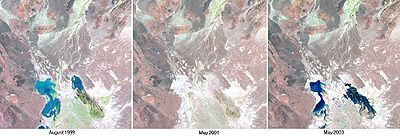Godzareh Depression

The Gowd-i zerrah, i.e., Zerrah Depression (Persian for "lake depression") is the lowest part of an inland drainage basin covering large parts of southern Afghanistan and Iran known as the Sistan Basin. The Sistan Basin is an endorheic basin and encompasses a complex system of rivers, shallow lakes, marshes and wetlands as its watershed, draining into the Hamun Lakes in southeastern Iran. Occasional outflows from these lakes are carried back into Afghanistan by the seasonal Shile river to the basin's terminus, the Godzareh depression in Afghanistan. The depression is flat and very shallow with fine textured sediment at its lowest portions. The lowest section of the Godzareh depression is 467 m above sea level. The depression only receives runoff water when the main tributaries are overflowing every 10 years on the average.[1][2][3]
In general, a geological depression is a landform that is sunken or lower than the surrounding area. The Godzareh depression is the lowest point in the Sistan Basin in Afghanistan and therefore is the terminus to which all the water flows.[4]
Water supply obligations
[edit]Under an accord signed between Iran and Afghanistan in 1972, Afghanistan is obliged to release water at a rate of at least 910 cubic feet per second (26 m3/s). The Helmand River water agreement was signed in 1972 between Mohammad Musa Shafiq and Amir-Abbas Hoveyda,[5] the then prime ministers of the country and Iran. The Taliban briefly stopped the flow of water to Iran when the latter threatened to attack in retaliation for the killing of Iranians who were claimed to be diplomats in Mazari Sharif when the Taliban retook the city from the Northern Alliance the second time in 1998. During that time Helmand valley was going through a five-year drought.
To make good on its threat, the Taliban diverted southward, through a canal the entire flow of the Helmand, into the Gowd Zerrah/Zerah Depression (Godzareh depression). While the Zerah filled up with Helmand waters and uselessly, Iran's famous Hamun-e Helmand lake dried up as did other regional pastures, leading to the death of flora, fauna, cattle and birds in the Sistan and Baluchestan Province of Iran.[6]

. Satellite photos taken at the time, show the changes this caused.
See also
[edit]References
[edit]- ^ "The Geography of Hamun". Retrieved 2007-07-20.[permanent dead link]
- ^ "DAŠT-e NĀWOR". Encyclopaedia Iranica. Retrieved 2007-07-20.
- ^ "IWRM for the Sistan Closed Inland Delta, Iran" (PDF). WL Delft Hydraulics. Retrieved 2009-02-18.[permanent dead link]
- ^ "Restoration, Protection and Sustainable Use of the Sistan Basin". Retrieved 2007-07-20.
- ^ Daily, 8am (2022-02-11). "MEW Officially Recognizes Helmand River Treaty". Hasht-e Subh Daily. Retrieved 2023-05-19.
{{cite web}}: CS1 maint: numeric names: authors list (link) - ^ Hirmand River's water to flow into Iran again, soon: Afghan source Archived 2015-09-24 at the Wayback Machine, December 12, 2002
